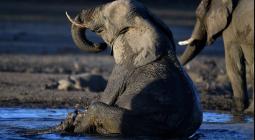The U.S. Imported Billions of Animals in Recent Decades, Fueling Global Wildlife Trade
Federal data only tells part of the story of how the global wildlife trade is fueling nature loss, a new study shows.
The global wildlife trade is a sprawling, multi-billion dollar market—and the United States is one of the biggest players. In the past roughly two decades, people in the U.S. legally imported about 2.9 billion animals from nearly 30,000 species, according to a recent study.
Wild animals and their parts are crucial for a number of domestic industries, from the pet trade to medical research. However, this widespread animal trade network has consequences, fueling extinctions, introducing invasive species to new environments and increasing the risk of disease spillover to humans. When animals are pulled from their habitats it can also hamper the species’ ability to adapt to climate change, particularly when they are illegally trafficked, research shows.
Experts say that the legal global wildlife trade can operate more sustainably, but only if countries—including the U.S.—make major reforms to data collection and the international treaty dedicated to overseeing trade.
Trade Across the Animal Kingdom: The wildlife trade describes the buying or selling of wild plants and animals, which includes products that are made from their parts. This can look different depending on the industry. Fishing and farming sectors are built on the exchange of natural resources, though plants and animals involved in these systems are typically bred for that purpose. The pet, zoo and aquarium trade frequently pulls animals from their native habitats, including reptiles, spiders, fish, chimpanzees and tigers—often procured and kept illegally (looking at you, Joe Exotic from “Tiger King”).
In the medical world, companies import almost 39,000 macaque monkeys annually for testing and trials. Traditional Chinese medicine is a major source of demand for wild animal parts as well, accounting for around 75 percent of the trade in endangered wildlife products in Hong Kong from 2014 to 2019, Reuters reports. Fashion also plays a big role in the global wildlife trade, using mink fur, snake scales and millions of crocodile skins for handbags, boots and more.
“I don’t think people have a good understanding of what [wildlife] trade actually is,” Andrew Rhyne, a marine biologist at Roger Williams University in Rhode Island, told me. He added that most of the trade is legal, but illicit activities are widespread, too. “It’s a massive, very biodiverse, very global trade, and the U.S. is one of the largest consumers in the world of it.”
But this massive market has a monitoring problem. There is no comprehensive global dataset on which species are being traded, their geographic origins and the trade’s ultimate impacts, which limits our ability to sustainably manage it, according to a December study Rhyne co-authored. To get a better understanding of the magnitude of the legal wildlife trade coming into the U.S., the international team of researchers analyzed around two decades’ worth of entries in the country’s Law Enforcement Management Information System, which tracks the wildlife traded across the border.
They found that terrestrial mammals were far and away the most traded animals by number of entries, followed by echinoderms like sea cucumbers or starfish and cnidaria, which include corals. They also found that more than half of the traded individuals imported into the U.S. came directly from the wild, instead of being captive bred.
Although the U.S. has the “best wildlife trade data in the world,” there are still big data gaps in the market, largely because wildlife inspectors and customs agents are often overwhelmed by the sheer number and variety of animals being traded, Rhyne says.
In many countries, there is little to no data on the impact of the legal wildlife trade on most wild populations. But research shows that this market is linked to the endangerment and even disappearance of certain species such as the pass stubfoot toad from Costa Rica, which was declared extinct in 2019. Improving trade tracking data around the world will be crucial to protecting species and even preventing disease outbreaks that originate in wild animals, the new study found.
The Illegal Side: In 1973, delegates from 80 countries agreed on a treaty known as the Convention on International Trade in Endangered Species of Wild Fauna and Flora (CITES), which was designed to help ensure that international trade in plants and animals does not threaten their survival in the wild. Administered by the United Nations, CITES affords special protections for more than 40,900 plant and animal species, and maintains a trade database of member parties. Today, there are more than 180 countries signed on, including the U.S. and nations in the European Union.
Despite this, illegal wildlife trafficking is rampant around the world, according to a 2024 United Nations report. From 2015 to 2021, illegal trade affected roughly 4,000 plant and animal species with approximately 3,250 listed under CITES. In that same period, law enforcement bodies confiscated 13 million items weighing a total of more than 16,000 tons.
“Wildlife crime inflicts untold harm upon nature and it also jeopardizes livelihoods, public health, good governance and our planet’s ability to fight climate change,” Ghada Waly, executive director of the UN’s Office on Drugs and Crime, said in a statement about the report.
Last week, Interpol and the World Customs Organization announced a major bust in the illegal wildlife trafficking world, Mongabay reports. During an operation at the end of 2024, the agencies uncovered six transnational criminal wildlife networks and made 365 arrests. More than 20,000 live animals were rescued, including birds, turtles, big cats and pangolins—an armadillo-like mammal that is the most heavily trafficked animal in the world.
“Organized crime networks are profiting from the demand for rare plants and animals, exploiting nature to fuel human greed,” Valdecy Urquiza, the secretary general of Interpol, said in a statement.
Part of the problem is that the demand for wild animals and their parts remains high in much of the world, and reforming this market can be complicated. In some cases, banning wildlife trade in one threatened species could actually increase the trade of a different threatened species, according to recent research.
The wildlife trade is also a critical source of income for many rural communities, particularly in Africa, so outlawing certain exports could threaten livelihoods. Experts at the University of Oxford recently developed a decision-making tool that they say could help reform CITES in a way that benefits communities and wildlife. Possible strategies include giving Indigenous and local communities more control over how species are used or developing programs that reduce consumer demand.
But preventing biodiversity loss in both the legal and illegal global wildlife trade is a gargantuan problem and solutions won’t be straightforward, Rhyne said. Still, his team forges on.
“If you don’t try your hardest and things are terrible in 20 years, how do you sleep at night, right?” Rhyne said. “I think we just have to find ways to actually impact biodiversity and that might not be anything that happens in the United States. It might be people supporting legitimate groups who are legitimately working on the ground in countries where they can actually impact and improve biodiversity.”
North Atlantic Right Whale Breaking Update
The National Oceanic and Atmospheric Administration (NOAA) is facing big changes under the Trump administration, which could affect accessibility to weather forecasts and climate data. These changes could also disrupt measures to protect endangered species at sea.
NOAA Fisheries announced the cancellation of several upcoming meetings for marine mammal take reduction teams on the East and West coasts. These federally convened groups are responsible for creating plans that help reduce deaths and serious injuries among legally protected marine mammals. That includes the Atlantic Large Whale Take Reduction Team, which has been working on strategies to help protect the endangered North Atlantic right whale, of which there are only around 370 individuals left.
Several members of the team expressed dismay over what the meeting’s cancellation could mean for the whales.
“I’m very disappointed,” Erin Meyer-Gutbrod, a team member and an assistant professor at the University of South Carolina who studies whales, said over email. “Delaying or cancelling the Atlantic Large Whale Take Reduction Team meeting will delay or prevent the Team from sharing data, assessing the range of stakeholder needs and, ultimately, developing a suitable plan for reducing the risk of whale entanglement in fishing gear.”
Erica Fuller, team member and senior counsel at the Conservation Law Foundation, echoed these concerns.
“I don’t have special intel but imagine that the chaos this administration has heaped on NOAA, an agency just trying to keep us safe, comply with federal laws such as the [Endangered Species Act] and [Marine Mammal Protection Act], and manage federal fisheries, has made it impossible for them to do their job right now,” she told me over email. “We are already behind the 8 ball and any further delay in convening the Team is unacceptable.”
In a statement to ICN, NOAA said that updates to the team will be provided soon.
“NOAA remains committed to working with stakeholders to advance efforts in protecting endangered large whale species while addressing the concerns of affected industries and communities,” the statement said.
More Top Climate News
The recent wildfires in greater Los Angeles pushed California’s state-backed “last-resort” insurance plan—designed for people who can’t get coverage from private companies—past its ability to pay out claims. On Tuesday, state regulators said that they will allow the program, known as the FAIR Plan, to collect $1 billion from private insurance companies operating in California to cover costs, Laurence Darmiento reports for The Los Angeles Times.
This is likely to increase insurance premiums for homeowners all over California—not just in the LA area. This necessary bailout signals a new and concerning phase in California’s climate-shocked insurance market and could motivate more companies to pull out of the state altogether, experts say. I wrote about the FAIR plan in January if you are curious about how the mechanism works.
Meanwhile, the Federal Emergency Management Agency will “pause” enforcement of rules designed to protect public buildings from flooding, Christopher Flavelle reports for The New York Times. The Biden-era rule, dubbed the Federal Flood Risk Management Standard, says that when public buildings like schools or libraries are located in a flood zone and get damaged or destroyed, those structures must be rebuilt in a way that reduces the chances of flood damage if they are to qualify for FEMA funding. Legal experts told The Times that FEMA cannot stop enforcing this rule beyond a short pause without following certain regulatory steps, which could take months or longer.
Grist published an interactive tool that allows users to track what kinds of climate and infrastructure projects have been announced in their neighborhoods—a number of which are at risk under President Donald Trump. Prior to Trump entering office, lawmakers had announced nearly $700 billion in funding for infrastructure- and climate-related projects under the Inflation Reduction Act and the Bipartisan Infrastructure Law. But the fate of many not-yet-disbursed funds is up in the air in light of recent federal freezes.
Federal courts have ordered the government to temporarily restart that spending. On Monday, a judge ruled that the Trump administration was ignoring his prior order. On Thursday, the administration started a widespread firing spree, laying off employees from the Department of Energy, the U.S. Forest Service and the Office of Personnel Management, E&E News reports.
“Per OPM instructions, DOE finds that your further employment would not be in the public interest,” said an email sent to a DOE employee Thursday and viewed by E&E News. “For this reason, you are being removed from your position with DOE and the federal civil service effective today.”
This round of layoffs is targeting federal employees on probationary status, which marks those with less than a year of government experience. This could affect hundreds of thousands of workers, CBS News reports.
Cover photo: The heads of tigers that were confiscated by U.S authorities line shelves in the National Wildlife Property Repository at the Rocky Mountain Arsenal in Commerce City, Colorado. The repository is the national receiving and storage facility for wildlife products seized by the U.S. Fish and Wildlife Service's Office of Law Enforcement and its law enforcement partners. There are roughly 1.5 million items in the collection, derived from various wildlife species from around the world, but no live specimens are kept there. Credit: Michael Kodas/Inside Climate News




